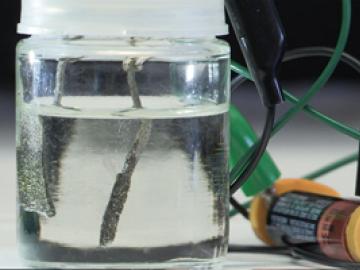Filter News
Area of Research
- (-) Data (1)
- (-) Materials Characterization (2)
- (-) Materials Synthesis from Atoms to Systems (13)
- Advanced Manufacturing (34)
- Biological Systems (18)
- Biology and Environment (177)
- Biology and Soft Matter (5)
- Building Technologies (12)
- Chemical and Engineering Materials (4)
- Chemistry and Physics at Interfaces (11)
- Clean Energy (522)
- Climate and Environmental Systems (14)
- Computational Biology (6)
- Computational Chemistry (5)
- Computational Engineering (5)
- Computer Science (19)
- Earth Sciences (1)
- Electricity and Smart Grid (3)
- Energy Frontier Research Centers (14)
- Energy Sciences (5)
- Fossil Energy (3)
- Fuel Cycle Science and Technology (3)
- Functional Materials for Energy (16)
- Fusion and Fission (54)
- Fusion Energy (17)
- Geographic Information Science and Technology (3)
- Isotope Development and Production (3)
- Isotopes (35)
- Materials (433)
- Materials for Computing (36)
- Materials Under Extremes (12)
- Mathematics (1)
- National Security (79)
- Neutron Data Analysis and Visualization (4)
- Neutron Science (190)
- Nuclear Science and Technology (74)
- Nuclear Systems Modeling, Simulation and Validation (3)
- Nuclear Systems Technology (1)
- Quantum Condensed Matter (4)
- Quantum information Science (9)
- Reactor Technology (1)
- Renewable Energy (4)
- Sensors and Controls (5)
- Supercomputing (311)
- Transportation Systems (11)
News Topics
Media Contacts

Zheng Gai, a senior staff scientist at ORNL’s Center for Nanophase Materials Sciences, has been selected as editor-in-chief of the Spin Crossover and Spintronics section of Magnetochemistry.

Jordan Hachtel, a research scientist at ORNL’s Center for Nanophase Materials, has been elected to the Board of Directors for the Microanalysis Society.

Supercomputers like Oak Ridge National Laboratory’s Titan are advancing science at a frenetic pace and helping researchers make sense of data that could have easily been missed, says Ramakrishnan “Ramki” Kannan. Kannan, a computer scientist who came to ORNL in March 2016 after ...


From the bluebird painting propped against her office wall and the deer she mentions seeing outside her office window, Linda Lewis might be mistaken for a wildlife biologist at first glance. But rather than trailing animal tracks, Lewis, a researcher at the Department of Energy’s Oak Ridge National Laboratory, is more interested in marks left behind by humans.

With more than 30 patents, James Klett is no stranger to success, but perhaps the Oak Ridge National Laboratory researcher’s most noteworthy achievement didn’t start out so hot – or so it seemed at the time.

Graphene, a strong, lightweight carbon honeycombed structure that’s only one atom thick, holds great promise for energy research and development. Recently scientists with the Fluid Interface Reactions, Structures, and Transport (FIRST) Energy Frontier Research Center (EFRC), led by the US Department of Energy’s Oak Ridge National Laboratory, revealed graphene can serve as a proton-selective permeable membrane, providing a new basis for streamlined and more efficient energy technologies such as improved fuel cells.

Andrew Stack, a geochemist at the Department of Energy’s Oak Ridge National Laboratory, advances understanding of the dynamics of minerals underground.






